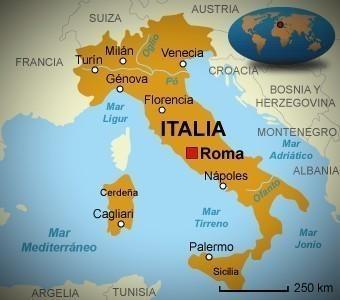How to apply for asylum in Italy?
The countries of the European Union (EU) , throughout history, have been the most valued by citizens of Asia, Africa and Latin America who are looking for a second homeland. In Italy, for example, 11% of its population is foreign, which is equivalent to 6.2 million people; being these, figures that suffered a sudden increase from 2022. Discover what is the reason for the effervescence of the migratory movement towards said territory.
Foreigners in Italy come from multiple nations, such as: Romania, Albania, Morocco, China, India, Egypt and Brazil . According to the surveys carried out by the European Commission, the choice of the country is attributed:
- 39% to the quality of life that families can achieve
- 17% to job opportunities offered by the country
- 9% to asylum applications . Which reflects that the approval percentages to provide protection to those who seek refuge are low.
In fact, the United Nations High Commissioner for Refugees (UNHCR) indicates that, in 2022, only 14% of cases had satisfactory responses. And they mainly favored those fleeing from Kenya, Tanzania, Jordan, Nicaragua, Venezuela and Palestine . It is not impossible, but it is a painstaking process . Therefore, we will tell you the correct steps to follow to seek the protection you need in Italy.
Who can apply for asylum in Italy
Please note that the body in charge of processing the applications is the territorial commission belonging to the Ministry of the Interior. We clarify the point, because the petitioners often get confused and demand answers at the police stations, where they should go initially. This will be explained in more detail in the next section.
On the other hand, there are 32 countries that are governed by the Dublin Regulation, Italy being one of them. The same states that, requests for protection can be assigned to any of the nations that have the necessary competences. This is the case when:
- Another nation, registered in the Dublin regulation, has a file on the applicant; whether it has granted you a visa, work permit, residence, etc., before.
- If before arriving in Italy, you passed through any of the other 31 countries that are part of the convention. The first one you entered, regardless of the way you did it, has the priority to analyze the case.
- The petitioner has at least one family member in another of the countries subject to the agreement.
However, if your desire is to remain in Italy until the procedure is resolved, but you are a candidate to be transferred, based on the above, then you should seek legal assistance.
There are free lawyers at the centers at your disposal to appeal the change of nation.
NOTE: the countries that apply the Dublin Regulation are all the countries of the European Union, which total 28. In addition, Norway, Iceland, Switzerland and Liechtenstein.
International protection in Italy
On the other hand, it is necessary to note that international protection in Italy is free and has two categories. Let’s see what each one is about:
- Refugee protection. It is granted to people who refuse to return to their country of origin, where they are persecuted for racial or religious discrimination, political differences, gender preferences or membership in certain social groups. And in which, for some reason, the security entities do not provide a solution or peace of mind; but rather they work for unjustified arrests or ignore conduct or threats to life that violate human rights.
- Subsidiary protection. Applies when the individual cannot be classified as a refugee; but, he also runs risks, which threaten his integrity, in his nation. Armed conflicts and death sentences are the ones that best define this benefit.
Stateless persons respond well to both definitions; These are people who do not have a citizenship of the country where they have lived for the last few years. Concept that is often attributed to individuals from Cuba .
Other considerations
The application for protection in the Italian territory is an individual process , unlike other countries; in which, the procedure can be carried out as a family group . With the exception of minor children , who are absorbed at the request of one of the parents.
For its part, the laws of Italy do not have defined deadlines to start the asylum application after entering the country; however, it is recommended to do it as soon as possible. Please note that if you are detained by the Center for Permanence for Repatriation (CPR) , you will similarly have the right to file your petition.
Safe countries
Finally, it is essential to know that the Ministry of the Interior will not process any procedure from a person born in any of the countries of the European Union . Also, this body is thorough with the requests of immigrants fleeing from nations that are considered safe , such as:
- Ukraine
- Montenegro
- Tunisia
- Cape Verde
- Morocco
- Algeria
- Serbia
- Senegal
- North Macedonia
- Albania
- Ghana
- Kosovo
- Bosnia- Herzegovina
Procedure to apply for international protection
Regardless of the category of protection to which you belong (refugee or subsidiary), you must go in person to the police assistance centers. You can do this at the border or at any of the offices authorized by the Immigration Department, if you are in Italy. Once you have executed what is defined as the manifestation, the next steps are:
Step 1. ID
When you announce to the assigned officer that you require international protection, he will proceed to record your personal data, such as names, place and date of birth, relationship and nationality. After that, he/she will take several photographs and fingerprints, which is also valid for minors over 14 years of age.
The officer has to validate this information to allow you to enter or continue in the territory, which does not happen instantly. For this reason, you will be detained until that moment. If one month passes and there is still no certainty of identification, you will be transferred to a CPR (asylum house) for a maximum period of 180 days.
Step 2. Presentation of model C3
Once your personal data has been validated, the police officer will ask you a series of questions related to your level of education, previous employment, religious beliefs, current address (if you are within the territory) and spoken languages . You can also inquire about the trip and the reasons for wanting protection from the country. If you do not speak Italian, you will have the right to an interpreter .
Later, although it is not mandatory, it is appropriate that you deliver all the documents that identify you and support your entry into the country; such as: passport, travel ticket and evidence of persecution (under confidentiality). This is also the right time to report if you suffer from serious pathologies, physical limitations or psychological trauma , if you have minor children or if you lack sufficient financial resources to live in Italy.
Depending on the statement, the police officer will be able to provide you with accommodation in shelters, medical assistance and even pressure for the case to be evaluated as soon as possible. Each point will be settled in an official letter, called model C3 , which you will sign together with the official and the interpreter (if applicable). Wait or request a photocopy of the document.
Step 3. Interview
At the address you indicated, you will be sent a notification to attend a meeting with an official of the territorial commission, who will be in charge of evaluating the reasons for your request. Therefore, once again, it will be essential that you bring the evidence supporting your request.
On this occasion, you will again have the right to request the presence of an interpreter of your mother tongue at no cost. In addition, you will be able to choose the gender of the interviewer, so that you feel completely comfortable in expressing the situation.
If you wish, you can present yourself with a lawyer on this day. However, this is not part of the free assistance provided by the ministry, i.e., the costs would be at your own expense. Also, if the trauma experienced has been severe and it affects you to narrate the facts, you can use specific resources, such as, for example, that a psychologist or a social worker accompanies you.
The session will be recorded and the dialogue will be transcribed in the hearing record. However, you do not have to worry, because it is completely confidential material that will be stored in encrypted databases: Vesta.net and Dublinet.
At the end, the corresponding record will be read and you will have to indicate if the data is correct; if not, the necessary modifications will be made. Afterwards, you will sign in agreement with the official and interpreter (if applicable). You will be given a photocopy of the document.
Step 4. Case evaluation and decision
To make a decision on the request for international protection, an internal meeting will be held between the president of the territorial commission , a UNHCR agent and two officials from the Ministry of the Interior , one of them being the interviewer. Considering the elements delivered, they will be able to conclude:
- Admission of refugee status or subsidiary protection . They will point out where to look for the travel document and residence permit, valid for five years.
- Special protection. They are six-month residence permits, which can be extended and exchanged for employment authorizations. They apply when there is evidence of domestic violence, labor exploitation, natural disasters or serious medical conditions.
- Application denial. The information given is not relevant or is not related to what was exposed in the interview, which is called manifestly unfounded.
If you live in a reception center, the operator of the place will give you the written resolution. But if you have a registered private address, you will receive the notification by postal mail . In both cases, you will have to sign the receipt ; Therefore, if you are not there at the time, you must appear within a period of 20 days at the police station where you started the process to receive the document.
Protection request rejected
If this is the case, in the written resolution, you will see that you have a period of 20 days to leave the country; but, on the next line, you are given a specific deadline , during which you can appeal the decision before an immigration court judge . For this, you will require legal assistance ; which will be provided to you by the territorial commission, at no cost.
While waiting for the hearing, you will usually have the right to remain in Italy . With two exceptions:
- You have submitted applications repeatedly, without significant changes in the situation
- The rejection was immediate , at step #1, due to lack of data.
Rights and obligations
The Ministry of the Interior and UNHCR work together to provide the maximum possible support to people who are in the country, as applicants or beneficiaries of international protection. This is based on the establishment of the following rights and duties:
| Rights | Duties |
| Remain in Italy, as long as the police have not determined the immediate rejection of your application. | Respect the laws of the country. |
| Have proof of being an applicant for international protection, to reside without problems in the country (while the status is defined). | Cooperate with all the information requested in the process, by the competent bodies. |
| Free education and health services. | Keep the place of residence updated, so that you can receive notifications in a timely manner. |
| Work permit, after two months of submitting the application at the police station. | Stay in Italy until the case is resolved. |
| To be admitted to the reception system, if you declare that you do not have resources for housing, food, clothing and hygiene. And receive psychological help (if applicable). | Go to the reception system, and respect its regulations. |
| Have a document or travel title to move, when admitted to the international protection of Italy. But, only when it is impossible for you to apply for a passport at the embassies or consulates of your country of origin. | Not return to the country of origin, for any reason (neither while you are an applicant, nor after you have received protection approval). |
| Apply for permanent residence after five years in the country, under international refugee protection. | Leave Italy if international protection ceases. This will happen if the risk conditions in your country of origin change drastically. |
| Apply for permanent residence, after having been in the country for ten years, under the benefit of subsidiary protection. | Leaving the territory if the territorial commission revokes the protection. |
| Equal conditions in the labor market. |
In conclusion, in order to apply for asylum in Italy it is essential that you are at risk in your home country and that you have sufficient evidence to support your story during any part of the process. Certainly, the ministry makes an effort to help as many foreigners as possible, but it must also ensure that the quality of life of its inhabitants remains optimal.









